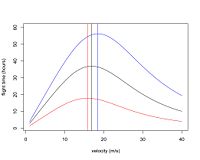Grouping behavior and the evolution of animal migration: Difference between revisions
From Santa Fe Institute Events Wiki
No edit summary |
|||
| (3 intermediate revisions by 2 users not shown) | |||
| Line 12: | Line 12: | ||
<br/> | <br/> | ||
==Questions/ Objectives (current and future) | ==Questions/ Objectives (current and future)== | ||
(1) How does limitation in fuel storage affect population viability? <br/> | (1) How does limitation in fuel storage affect population viability? <br/> | ||
| Line 24: | Line 24: | ||
[http://media.eurekalert.org/release_graphics/pdf/07%20February%20Article%20Drake.pdf What is migration? (Dingle & Drake 2007)] | [http://media.eurekalert.org/release_graphics/pdf/07%20February%20Article%20Drake.pdf What is migration? (Dingle & Drake 2007)] | ||
==Presentation Slides== | |||
[[Media:Evolution_Migration_Talk.pdf]] | |||
Latest revision as of 13:38, 26 June 2010
Participants
Andrew Hein
Ana Hocevar
Daniel Jones
Oana Carja
Kyla Dahlin
Project Summary
In the first week of the CSSS Ian Couzin presented models suggesting that migrating animal populations may evolve into sub-populations of individuals that are more informed and individuals that are more social (see an example [[1]]). However, his approach is far removed from the actual constraints that migrating animals experience. Starting from Couzin's model, we developed a framework that includes the amount of fuel animals can store and how that fuel is lost when the animals communicate or are force to travel at sub-optimal velocities to maintain a flock. As an initial model we have used data for migratory birds, assuming a small (N=300) population travelling 2000 km without stopping to refuel. We find that the added pressure to maintain fuel stores will drives the population to be more informed than was found in the Couzin papers.
Questions/ Objectives (current and future)
(1) How does limitation in fuel storage affect population viability?
(2) Is there a trade-off between time/distance taken to reach target and number of informed individuals?
(3) Is maximum group size related to the radius of socialization?
(4) Does varying the amount of mutation / selection algorithm change the results significantly?
Background Info

What is migration? (Dingle & Drake 2007)
